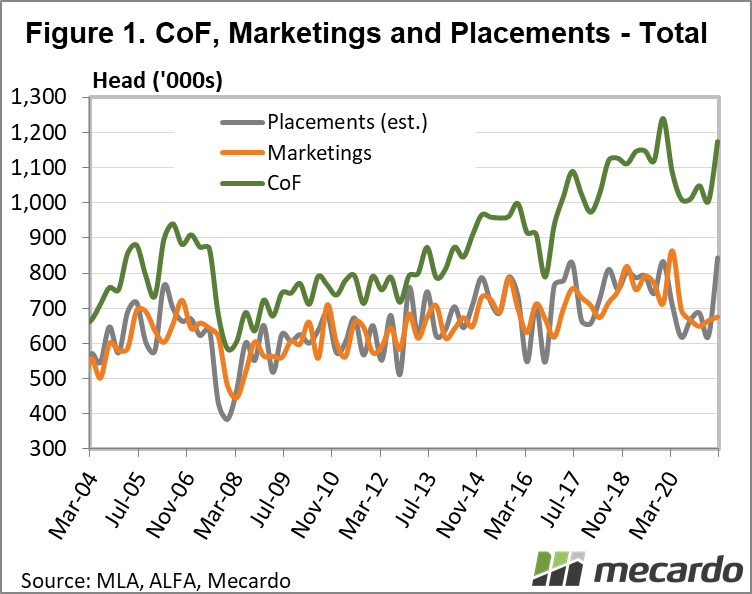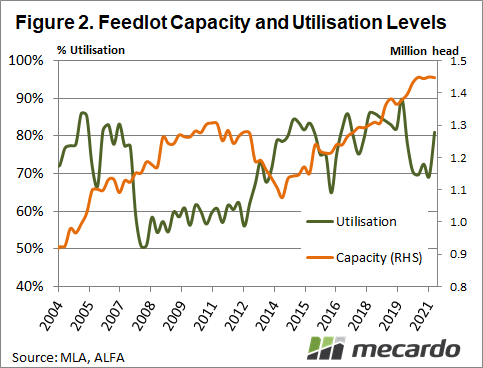Feeder steer and grain prices were both on the rise in the June quarter, but that hasn’t deterred lotfeeders, with cattle on feed numbers lifting 15% from the previous three months. It is the highest number of cattle on feed since the December 2019 quarter, and utilisation has lifted 12% on the previous quarter.
Cattle on feed for the June quarter lifted to 1,173,652 head, up 16.5% on the same quarter last year, and 11% higher than the five-year average for the same time period. This lifted national feedlot utilisation to 81%. Queensland had the most significant increase, with an extra 24% on feed compared to the March quarter. The feedlot capacity in Queensland also lifted, meaning utilisation didn’t climb as much as cattle on feed numbers, rising 25% to 85%. Utilisation was relatively stable for all other states except Victoria, which was up 9% (numbers on feed rose and capacity fell in Victoria).
Looking at inputs, the National Feeder Steer Indicator averaged 461ȼ/kg for the March to June period. This is a record quarterly average for the indicator, and up from 371ȼ/kg in the June 2020 quarter (keeping in mind this was a CV-19 price). Currently, the national price is at 493ȼ/kg, up 116ȼ/kg on the same time last year. The NSW Feeder Steer Indicator is leading the charge at 515ȼ/kg, which is 118 ȼ/kg higher year-on-year. The Meat & Livestock Australia and Australian Lotfeeder Association’s quarterly survey report has ex-Darling Downs wheat prices also up on the March quarter, by 2% to average $311/tonne – however this is considerably lower than the $430/tonne average price in June 2020.
When it comes to returns, the Queensland 100-day Grainfed Steer Over-The-Hooks Indicator averaged 666ȼ/kg, back 11ȼ/kg from the March quarter, but more than a 100ȼ/kg higher than the same period 12 months ago. Marketings rose slightly, but remained 8% lower than the five-year-average, and 3% lower than the same quarter in 2020.
Grainfed beef exports increased by 8% in the June quarter, to 77,757 tonnes shipped weight. Volumes for the year-to-July are down year-on-year by 2%, but total Australian beef exports for the same period are back 22%, with grainfed beef filling a significant supply gap. Grainfed exports for that period to South Korea – our second largest market for grainfed beef – have risen 20% year on year, while our largest market, Japan, has taken 10% less. China, ranked third in grainfed exports, is down 15% year-on-year.
What does it mean?
At the previous quarterly data drop, it looked as though elevated feeder prices would have to eventually put downward pressure on numbers on feed – but the need for grainfed product to fill the export demand has counteracted that. Grainfed cattle are likely further underpinning supply now (ABS official slaughter figures released tomorrow), and the September quarter data will show us if this is a new normal, even during heightened spring turnoff. Our next look at lotfeeder margins will also show us if the sector can keep going at the current pace.
Have any questions or comments?
Key Points
- Cattle on feed numbers remain above 1 million head for the June quarter.
- Feedlot utilisation rose to 81% for the June quarter, 3% higher than the five-year-average.
- Grainfed exports only back 2% for the year-to-date, compared to grassfed which has lost 29%.
Click to expand
Click to expand
Data sources: Mecardo, Meat & Livestock Australia, Australian Lotfeeders Association














